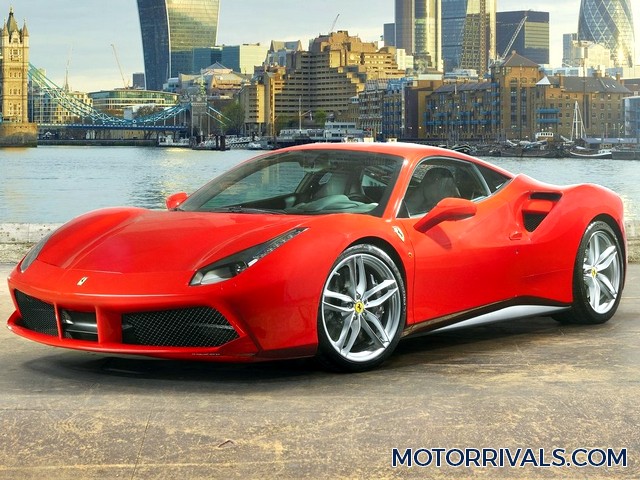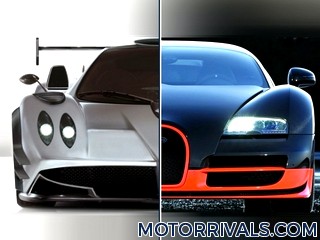2016 Ferrari 488 GTB vs 2015 Ferrari 458 Italia
Ferrari Press Release Highlights
The new berlinetta brilliantly encapsulates Ferrari’s
experience in both F1 and the WEC, where the 458 GT holds the World
Championship title and has won its category in the last two editions of
the 24 Hours of Le Mans. The new model also exploits to the full the
know-how gleaned by Ferrari technicians over the last decade through the
XX programme which makes extreme track-only cars available to gentleman
test-drivers. The data yielded has made a significant contribution to
the refinement of the electronic and vehicle control systems so that
drivers can make the most of the incredible performance of this new car.
Powertrain
The Ferrari 488 GTB’s new 3902 cc V8 turbo is at top
of the class for power output, torque and response times, making it the
new benchmark for this kind of architecture. The engine unleashes 670 cv
at 8,000 rpm along with 760 Nm of maximum torque in seventh gear and a
response time to the accelerator of just 0.8 seconds at 2,000 rpm. These
figures are sufficient to allow the 488 GTB to accelerate from 0-200
km/h in an astonishing 8.3 seconds and, when combined with the radical
innovations introduced on all aspects of the car’s performance, lap the
Fiorano track in just 1’23”.
The gearbox features Variable Torque Management which unleashes the engine’s massive torque smoothly and powerfully right across the rev range, while specific gear ratios deliver incredibly progressive acceleration when the driver floors the throttle. As is always the case, engineers have dedicated great attention to perfecting the Ferrari 488 GTB’s sound, creating a new soundtrack that is full, clear and totally distinctive, as expected from any Prancing Horse engine.
Aerodynamics
The car’s aerodynamics
also made a pivotal contribution to performance: its 1.67 efficiency
figure is a new record for a production Ferrari and is the fruit of 50
per cent more downforce than the previous model and reduced drag. The
greatest challenge was achieving these two goals simultaneously. Several
innovative elements were specifically developed to do so, not least a
double front spoiler, base bleed side intakes and, at the rear, active
aerodynamics coupled with a blown spoiler. The aerodynamic underbody,
which incorporates vortex generators, is highly sophisticated, too.
Vehicle dynamics
The Ferrari 488 GTB’s subsystems and electronic
controls make its power and performance instantly available and
controllable. It is, in fact, the most responsive production model there
is, with razor-sharp response times comparable to those of a track car.
The evolved version of Ferrari’s side slip angle control system
(Side Slip Control 2 – SSC2), is more precise and less invasive,
providing greater longitudinal acceleration out of corners. Aside from
integrating with car’s F1-Trac and E-Diff, the SSC2 now also controls
the active dampers which renders the car’s dynamic behaviour during
complex manoeuvres even flatter and more stable.
Exterior design
Designed by the Ferrari Styling Centre, the new car features very
sculptural flanks which are the key to its character. Its large
signature air intake scallop is a nod to the original 308 GTB and is
divided into two sections by a splitter. The wide front spoiler features
a double profile to improve the thermal efficiency of the radiators
positioned at the sides. At the centre two pylons are combined with a
deflector which channels air towards the flat underbody. The broad, low
tail is also dominated by aerodynamic solutions, including an innovative
blown spoiler which generates downforce without increasing drag. This
works in conjunction with an aggressive ramp angle for the diffuser
which features active flaps. The greater height required for the
diffuser was achieved by repositioning the exhaust tailpipes. The
circular LED tail lights have also been redesigned.
Interior
design
In the cabin, the seamless integration of the new satellite
control clusters, angled air vents and instrument panel heightens the
sense that the cockpit is completely tailored around the driver.
Usability was the key word in the design, leading to an extremely sporty
ambience that in no way compromises on comfort. There are plenty of
classic Ferrari styling elements too, such as the clear separation
between the dashboard and tunnel, the multifunctional steering wheel,
the control switch bridge and wraparound seats. The graphics and
interface of the infotainment screen have also been completely
redesigned while the design of the Ferrari 488 GTB’s new key takes its
inspiration from the car’s cylinder banks and allows keyless starts.
Ferrari 488 GTB
Technical specifications
ENGINE
Type V8
– 90° Turbo
Overall displacement 3902 cm3
Maximum power * 492 kW
(670 CV) at 8000 rpm
Maximum torque * 760 Nm at 3000 rpm in VII gear
DIMENSIONS AND WEIGHT
Length 4568 mm
Width 1952 mm
Height
1213 mm
Dry weight** 1370 kg
Weight distribution 41.5% Front –
58.5% Rear
PERFORMANCE
0-60 mph 3.0 s (estimated)
0 -124
mph 8.3 s (estimated)
Maximum speed > 205 mph
FUEL CONSUMPTION***
20.6 mpg (estimated)


















